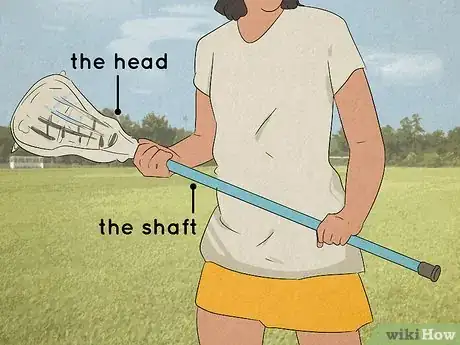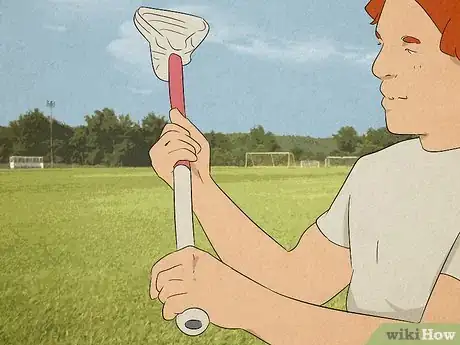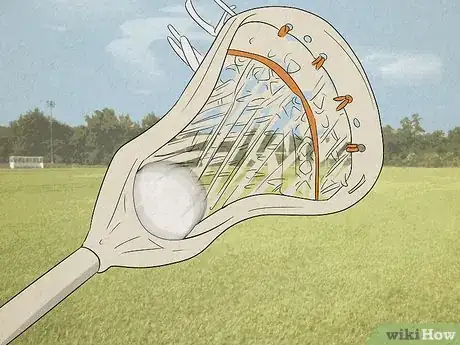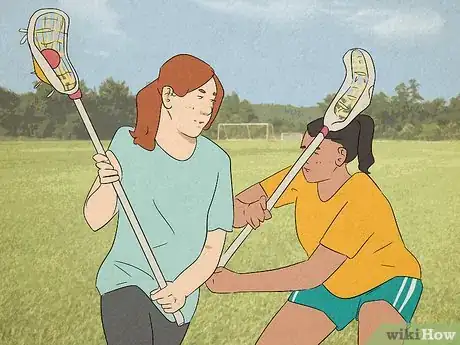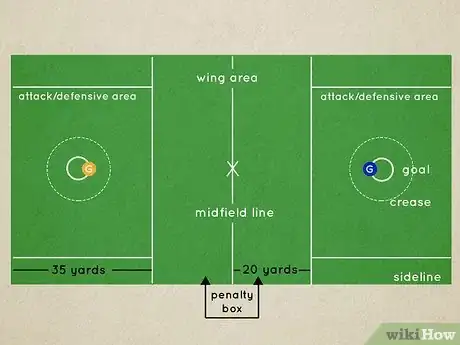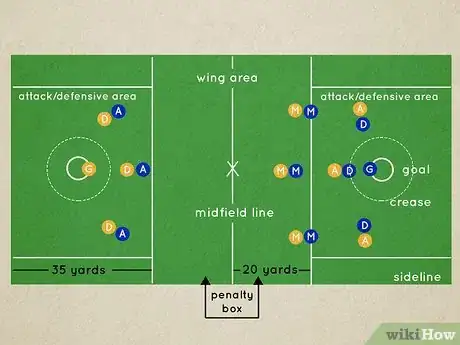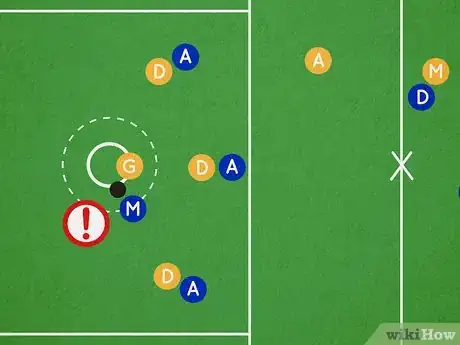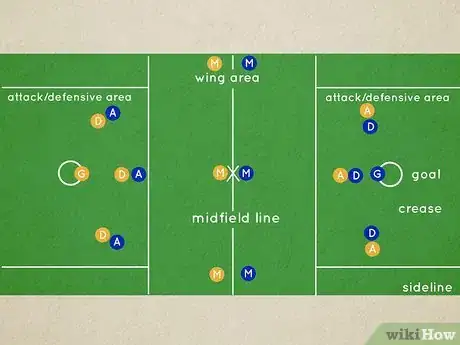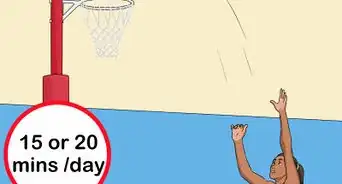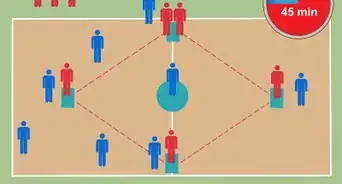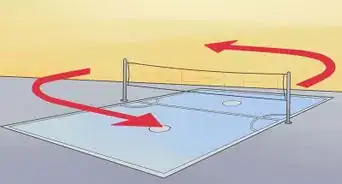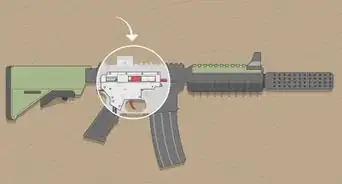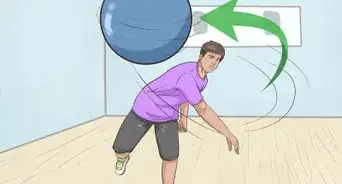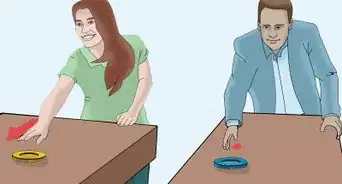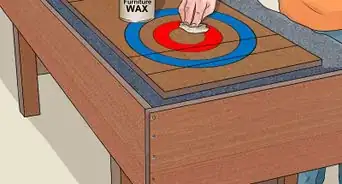wikiHow is a “wiki,” similar to Wikipedia, which means that many of our articles are co-written by multiple authors. To create this article, 120 people, some anonymous, worked to edit and improve it over time.
There are 7 references cited in this article, which can be found at the bottom of the page.
This article has been viewed 465,681 times.
Learn more...
Lacrosse originated as a native American sport.[1] In that form, it was a battle between sometimes hundreds of tribesmen, and very often turned violent. Lacrosse today is a rapidly growing sport, one that owes as much to finesse and trickery as it does to brute strength and violence. If you've ever been interested in learning how to play, you've come to the right place. Read on for more information.
Steps
Learning Essential Skills
-
1Get your hands on a stick. If you're just learning how to play, go to your local sporting goods store, and you can find a basic stick for around 30 dollars. If you know someone that has an old stick they wouldn't mind letting you borrow his or hers, even better. Understand that the men's and women's games differ significantly, meaning that the male stick is much different than the female stick.
- There are two main components of a stick:
- The head. This is the (usually plastic) piece at the top of the stick that the ball is controlled with.
- The shaft. Traditionally made out of wood, shafts nowadays are made of strong metal alloys and have varying weights and strength.
- There are two main components of a stick:
-
2Hold the stick in the proper way. If your dominant hand is your right, put your left hand about 1 or 2 inches (3 or 5 cm) from the bottom of the shaft and your right hand closer to the top, about 4 inches (10 cm) from the bottom of the head. Switch the hands around if your dominant hand is your left.Advertisement
-
3Learn how to cradle. Cradling is the lacrosse equivalent of dribbling in basketball. You usually cradle when you run with the ball so that an opponent can't knock the ball out of your stick. Cradling is basically using a curling motion with your wrist to swing the ball back and forth while you run.
- Cradling is best learned in front of a mirror. Place the ball in the pocket of your head, so that the ball sits in the mesh, holding your dominant hand a few inches below the head. Hold the stick across your body comfortably.
- Begin with the head facing the mirror so you can see the ball. Now bring the head across your face while curling your dominant wrist in towards your body.
- When your dominant wrist is curled as far as it can go inward, start bringing your wrist back out and your arm back down to its starting position.
- If you managed to keep the ball in the pocket while you completed that movement, you successfully cradled. Keep practicing until you get the hang of it. If you need help (don't worry, it's hard) try watching some videos of people playing lacrosse.
-
4Learn to pass. Passing is critical in Lacrosse. It's used to move the ball up field, catch your opponent out of position while hitting a teammate for an assist, or just getting yourself out of pressure.[2] In order to pass the ball:
- Lower your dominant hand down to just above the center of the shaft. Keep your non-dominant hand close to the bottom of the shaft.
- Bring the shaft of your stick back by twisting your shoulders toward your dominant side. Don't let it hook around your neck.
- Keeping the head next to your ear, and using a straight motion, flick the wrist of your top hand while pulling your bottom hand towards you.
- Make sure to follow through with the motion. A proper motion will see the top of the shaft move directly over the bottom of the shaft in a straight line.
- Note: eventually, you learn how your stick throws and can adjust the way you throw to be more accurate.
- Note: the best thing you can do to help improve your skills is get to a brick wall and play "wall ball." This is where you stand a few feet from the wall and throw the ball against it. The ball will bounce back and you practice catching it.
-
5Learn how to catch. This is all about hand-eye coordination. With your dominant hand up near the bottom of your head,(For righties this means have your right hand on top and left hand on the bottom and for lefties this means have your left hand at the top and right hand at the bottom) watch the ball travel through the air and into your pocket. Make sure you don't cradle as the ball enters your stick. Instead of cradling, simply loosen your grip on your top hand; as the ball enters the stick, let the momentum of the ball push the whole stick back a little bit.[3] Again, wall ball will really help here.
-
6Practice your ground balls. Know that games are won and lost on ground balls. While approaching the ball, step to it using the proper foot: if your stick is in your right hand, position your right foot close to the ball, and vice versa. Sink your hips and put the head of your stick parallel to the ground. The butt of your stick should get down low as well.[4] Scoop through and bring the head to your face. Immediately look for the outlet to a teammate.
-
7Learn how to shoot. Shooting the bass is necessary in order to score goals. Move your dominant hand down a little lower than you would to pass. Perform the same basic movement as passing, except this time, put more force behind it. There are plenty of different kinds of shots in lacrosse — 3/4, sidearm, underhand — but for now, focus on overhand shots.
- Try to direct the shots on the corners of the goal. The goalie has a harder time against shots that aren't directed right at him, so aim for top right, top left, bottom right, and bottom left. Also try shooting at the goalies weak side hip. So if the goalie is right handed, shoot at their left hip. Shooting at the goalies weak side hip make it hard for them to stop the ball mainly because it takes a lot speed and quick reflexes for the goalie to extend their arms with the stick across to the opposite side of their body, whether they move their stick upwards or downwards.
- Try bounce shots. Bounce shots are where you bounce the ball on the ground before it gets to the goal. Bounce shots are hard for a goalie to defend, so use them.
-
8Learn how to pass, catch, cradle and shoot with both hands. Nothing impresses a coach more than being ambidextrous! Learning to use both hands requires patience, because it will not happen overnight. Using your off hand in games will seriously improve your play.
- A good way to learn your off-hand skills is to look at what your dominate hand is doing. Mirror the way you are passing. Go through the same motions.
- After you do this, spend a week of practice using nothing but your non-dominant hand. During line drills, 6v6, fast break, anything. Only use your off-hand. This will be very frustrating, but keep at it.
-
9Learn how to defend. There's no one way to defend, but your object on defense is to recover the ball without the other team scoring. You can do this by checking, keeping your stick up and intercepting passes
- Boys Checking
- Poke-checking: hitting the other person's stick legally with your own, causing the ball to come out.
- Body-checking: hitting the other person legally with your own body, causing the ball to come out.
- Girls Checking
- Modified- a quick "tap" (hit and release) on the head of another girl's head of her stick. You can only do this when her head is below her shoulder
- Full (Varsity)- a "tap" (hit and release) on the head of another girl's head of her stick. You can check anytime when the girl's stick is not in her "bubble" (around her head).
- Intercepting a pass. Anticipate where a pass is going and catch it mid-air or bat it down.
- Boys Checking
-
10Learn to read the field and know when to move off the ball. As you play in more lacrosse games, it's important to watch more experienced team members move without the ball. Even players who don't have the ball play a very important role in a possession. You must know when to cut, and make space for passing, and shooting, and to draw defenders away from the person with the ball. You also should learn how and when to set picks for your teammates.
Knowing the Rules of the Game
-
1Understand that the men's and women's game is significantly different. Although the basic concepts are the same, women's lacrosse differs quite a bit from men's lacrosse.[5] This article will focus mainly on the rules of the men's game.
-
2Understand the object of the game. The object of lacrosse is to score more points than your opponents at the end of four quarters, which last for 15 minutes each. You score a point by throwing the ball across the goal line of the opponent's goal.
-
3Know the positions of lacrosse. 10 lacrosse players take the field for a game: 3 attack-men, 3 midfielders, 3 defenders, and 1 goalie. They each have different functions:[6]
- Attack-men: usually stay in the opponent's half and are responsible for creating fast breaks, moving the ball around in the opponent's half, and scoring goals.
- Midfielders: move the length of the field, help with attacking and defending, and are responsible for the faceoff.
- Defenders: usually stay in their half and keep the opponent's players from attacking. Defenders usually, but not always, have longer sticks than other players.
- Goalie: defends his team's goal, trying to keep the other team from scoring. Has a bigger-than-normal head on his stick for defending his goal.
-
4After each goal, and at the beginning of each quarter, start with a faceoff. A faceoff in lacrosse is similar to a faceoff in hockey, except that the two lacrosse players get down on their hands and knees and position their sticks parallel to each other. They then vie for the ball when the referee blows his whistle.[7]
-
5Know the basic play. After the faceoff is won, the team with the ball passes the ball until they are close enough to the opponent's goal to shoot. Meanwhile, the defenders try to keep the attacking team from scoring. A shot that travels past the goalie and into the goal counts as one point. Once a goal is scored, the ball is brought back to midfield, where a faceoff takes place again.
-
6Offensive players cannot enter the crease area around the opponent's goal. The crease is a large circle that is clearly marked.[8] If an offensive player steps into the crease illegally, possession is forfeited to the opposite team.
- There is not a minimum amount of time that a team has to possess the ball for before they score. Scoring can and does happen quickly.
- There is not a minimum amount of passes that need to take place before a player can shoot. Theoretically, a player could march down the field him or herself without ever passing the ball and still score.
-
7Understand the rules associated with timing. There are three rules associated with timing, and they both involve promoting the ball past forward.
- After the goalie gains possession of the ball, he must pass or move it out of the crease within 4 seconds. Failure to do so results in a turnover to the other team.
- Once the defense gains control of the ball in their defending half, they have 20 seconds to pass or run the ball over midfield.
- Once they've moved the ball past midfield, they have 10 seconds to get the ball into the attack area, which is clearly marked as a big box.
-
8Understand other unique rules of gameplay. Both involve possession of the ball:
- If a player takes a shot and the ball travels out of bounds, the team with a player closest to the end line gains possession of the ball. A player's stick counts as an extension of his body in this case.
- Inside the final two minutes of the game, the team with the lead must play inside their attack area exclusively. Failure to do so is considered delay of game, in which case forfeiture of possession occurs.
-
9Understand possession and offsides. When the faceoff is being fought for, a team's attackmen must be being the offensive restraining line and a team's defender must be behind the defensive restraining line. When possession is gained by either team, both attackmen and defence men may move toward midfield, but both teams must have three players above midfield and four defenders behind midfield.
-
Offsides. Defensive offsides occurs when there are fewer than four players for one team behind their midfield line. Offensive offsides occurs when there are fewer than three players for one team above their midfield line.
- Defenders can move past midfield and attackmen can move behind it so long as another player stays behind or in front of midfield in their stead. This allows for the possibility of a defender carrying the ball up past midfield, say, if a midfielder stays back to act as a "defender."
-
Offsides. Defensive offsides occurs when there are fewer than four players for one team behind their midfield line. Offensive offsides occurs when there are fewer than three players for one team above their midfield line.
-
10Assess penalties. Penalties usually send players into a designated area called the "penalty box," where they cannot play and must sit for a period of time. There are two kinds of fouls in lacrosse:
- Personal fouls. These include slashing, tripping, illegal cross checking, and checking from behind. A player is usually given 1 minute penalties, although penalties can be increased to 2 or 3 minutes or even ejection for egregious fouls.
- Technical fouls. These don't usually result in penalties, but rather a loss of possession. They include offsides, crease violations, pushing from the rear, thumbing, and warding off.
Community Q&A
-
QuestionWhat kind of padding is worn in the game of lacrosse?
 Community AnswerThere are many pads which must be worn in the boy's game. They include a helmet, gloves, elbow pads, and chest pads.
Community AnswerThere are many pads which must be worn in the boy's game. They include a helmet, gloves, elbow pads, and chest pads. -
QuestionCan I start playing lacrosse in high school or is it too late?
 Community AnswerYes. It is not too late.
Community AnswerYes. It is not too late. -
QuestionWhy do you need to wear mouthpiece?
 Community AnswerWearing a mouthpiece protects your jaw, mouth, and teeth if you happen to get hit in the face by a ball, stick, or player.
Community AnswerWearing a mouthpiece protects your jaw, mouth, and teeth if you happen to get hit in the face by a ball, stick, or player.
Warnings
- Lacrosse is a contact sport that involves people with metal sticks hurling dense rubber balls at each other. Always wear protective equipment and play safe.⧼thumbs_response⧽
- If you don't want to take these risks, don't play lacrosse. And hey, if you want to play a contact sport, take the appropriate measures.⧼thumbs_response⧽
- Never forget to wear a cup. A jock strap without a cup is not sufficient because if you get hit where it hurts, you will be seriously hurt.Wear a cup which is tight-fitting so the cup functions properly. A loose fitting cup will allow the cup itself to slam against the testicles, causing pain and possible injury.You can wear compression shorts over the cup-jockstrap and then your loose fitting lacross shorts over that.⧼thumbs_response⧽
Things You'll Need
- Lacrosse stick
- Ball
- Cleats
- Helmet
- Protective pads, including a mouth-piece and, if you're a boy, a cup jock-strap.
- A coach (Optional to take lessons from a coach. If you'd like to take lacrosse up as a hobby, a professional coach isn't essential. Sometimes, a fellow lacrosse player can be all you need, unless you'd like to take the sport a step further and play competitively)
- A team (once you've learnt the basics; sometimes, there are local teams in your area, so check if you've been wanting to join a team)
- Gloves
- A marked field or an open space to practice, preferably one used specifically for lacrosse and with goals.
References
- ↑ http://www.history.org/foundation/journal/winter10/lacrosse.cfm
- ↑ https://www.sportsrec.com/4244533/basic-lacrosse-skills
- ↑ https://www.sportsrec.com/4244533/basic-lacrosse-skills
- ↑ https://www.leagueathletics.com/Page.asp?n=10152&org=PTCLAX.COM
- ↑ https://theithacan.org/sports/lacrosse-has-different-rules-for-men-and-women/
- ↑ http://www.sportspectator.com/fancentral/lacrosse_men/guide03.html
- ↑ https://www.ducksters.com/sports/lacrosserules.php
- ↑ https://www.ducksters.com/sports/lacrosserules.php
- http://www.lacrosse-information.com
About This Article
Lacrosse is a popular sport played between two teams. Each team is composed of 10 players—three attackers, three midfielders, three defensemen, and one goalkeeper. The goal of the game is to score more points than the opposing team by using netted sticks to hurl a lacrosse ball into the opponent’s net. Each player carries a lacrosse stick. The goalies are the only players allowed to touch the ball with their hands. All other players use the net at the end of the stick to pass, shoot, pick up, and catch the ball. The game is typically divided into 4 quarters, although the length of the game differs depending on the age and gender of the players. Play begins with a “face-off” or “draw” at midfield. In men’s lacrosse, the ball is dropped on the ground and the two players use their sticks to fight over control. In women’s lacrosse, two players stand on opposite sides of the midfield line with the ball pressed in between the backs of their sticks. When the whistle blows, they attempt to fling the ball up into the air and secure possession. Gameplay continues until the ball goes out of bounds, a foul is called by a referee, or a player scores a goal. Once a goal is scored, the scoring team is awarded one point. Once a goal is scored, play resets with another “face-off” or “draw” at midfield. Much like hockey, checking is legal in Lacrosse so long as the player being checked either has the ball, or is within five yards of the ball. Players are also allowed to use their stick to knock away or disrupt the opponent’s stick at any time. As long as there are always at least four players behind the midfield line, the remaining players may move wherever they’d like. Players are not allowed to enter the opposing team’s “crease”, which is a circular area around the goal. Play continues until the clock expires, at which point the team with the most points is declared the winner. In the event of a tie, a sudden death overtime takes place and the first scoring team wins. To learn about the different field positions in lacrosse, scroll down!
